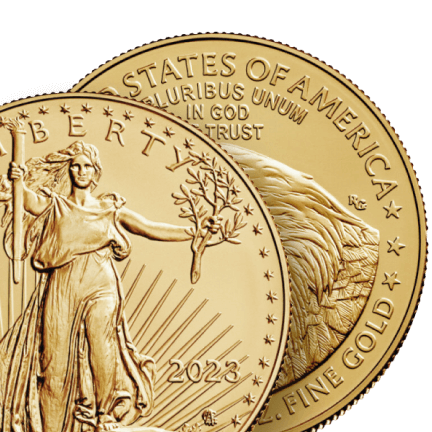For decades, financial advisors have preached the same gospel: allocate 60% of your portfolio to stocks and 40% to bonds. It’s been the cornerstone of “responsible” investing, the safe harbor endorsed by nearly every major financial institution.
Now, in a striking reversal, Goldman Sachs — one of Wall Street’s most influential voices — has released research that challenges this longstanding doctrine. Their findings? Adding gold to your portfolio doesn’t just improve returns slightly.
It nearly doubles them.
The Data that Debunks 60/40
In the latest episode of the GoldSilver Show, Mike Maloney and Alan Hibbard dissect Goldman’s groundbreaking research paper, “The Strategic Case for Gold and Oil in Long-Run Portfolios.”
The results are eye-opening: if you’d invested $1,000 in a traditional 60/40 stock-bond portfolio 23 years ago, you’d have about $5,800 today. But if you’d instead invested in a 60/40 gold-silver portfolio, your $1,000 would have grown to over $10,000.
That’s not a marginal improvement. That’s a complete game-changer.
Goldman Sachs Finally Joins the Gold Party
As Alan Hibbard points out in the video, this reversal is particularly significant given Goldman’s historical stance on gold. “I actually used to be a portfolio manager for institutional money,” Hibbard recalls, “and at one point I went to Goldman Sachs and said, ‘What about gold?’ And they laughed. They actually laughed out loud like they hadn’t heard a joke that funny in weeks.”
Mike Maloney adds his own perspective: “They’re coming to the party here about 24 years late. I started investing in gold in 2002 when it was $315. The history was already there.”
So, what changed? Why is Goldman Sachs suddenly championing gold after decades of dismissal?
The Perfect Storm for Precious Metals
Goldman’s research identifies several critical factors driving their new recommendation:
1. The Failure of Traditional Hedges
The report explicitly states: “Following the recent failure of US bonds to protect against equity downside… investors seek protection for equity-bond portfolios.” In other words, the traditional safety net has failed. When stocks fell recently, bonds didn’t rise to cushion the blow as they historically have.
2. Institutional Credibility Crisis
With US debt-to-GDP ratios approaching World War II levels—without an actual world war to justify them—Goldman warns of “elevated risks to US institutional credibility.” They note that gold serves as a critical hedge against losses in central bank and fiscal credibility.
3. Sustained Central Bank Demand
Central banks worldwide have been net buyers of gold for over a decade, and this trend is accelerating. Goldman acknowledges this as a fundamental shift that will continue to support gold prices.
Why Gold Isn’t Just Safer — It’s Smarter
Goldman’s analysis highlights a key point: gold improves both returns and safety. Their risk-return curves show:
- For the same level of risk, portfolios with gold generate higher returns
- For the same return target, portfolios with gold have lower volatility
This holds true even when excluding the 1970s gold bull market. Whether you measure from the 1980s, 1990s, or 2000s to today, gold improves portfolio performance across the board.

GoldSilver: Investing in Physical Metals Made Easy
GoldSilver lets you invest in real physical precious metals with flexible options to buy, sell, store, and take delivery. You’re in complete control.
Open an AccountWhy a Small Shift Could Create a Huge Price Surge
Perhaps the most explosive insight from Goldman’s research relates to market size. Global gold ETF holdings represent only about 1% of outstanding US Treasuries and just 0.5% of the S&P 500’s market cap.
As Goldman notes: “Even a small diversification step out of US fixed income or risk assets could cause the next giant leap for gold prices.”
Think about that. If just 1% of Treasury holders moved into gold ETFs, it would double the demand. The implications are staggering.
Goldman’s Price Targets: Conservative or Realistic?
Goldman forecasts gold reaching $3,700 per troy ounce by year-end and $4,000 by mid-2026. Both Mike Maloney and Alan Hibbard believe these estimates are far too conservative.
“There will be a giant leap, and their estimates of $3,700 and $4,000 are ridiculous,” Maloney states emphatically.
Given that gold has already moved from $250 to current levels, and considering the small size of the gold market relative to potential demand, their skepticism seems warranted.
Time to Rethink Your Allocation?
For over 20 years, precious metals investors were sidelined and scoffed at. Now, the very firms that once dismissed gold are echoing what Mike Maloney and others have said all along.
But this moment isn’t about vindication. It’s about opportunity — and protection. With institutional trust eroding and traditional hedges failing, the strategic case for precious metals has never been stronger.
Goldman Sachs may finally be onboard, but as Maloney points out, “They’re always doing yesterday’s news.”
The question isn’t if gold belongs in your portfolio. Goldman has answered that.
The real question is: will you act before the herd arrives?
Watch the full breakdown of Goldman Sachs’ gold research in the latest episode of the GoldSilver Show.
Get Gold & Silver Insights Direct to Your Inbox
Join thousands of smart investors who receive expert analysis, market updates, and exclusive deals every week.










